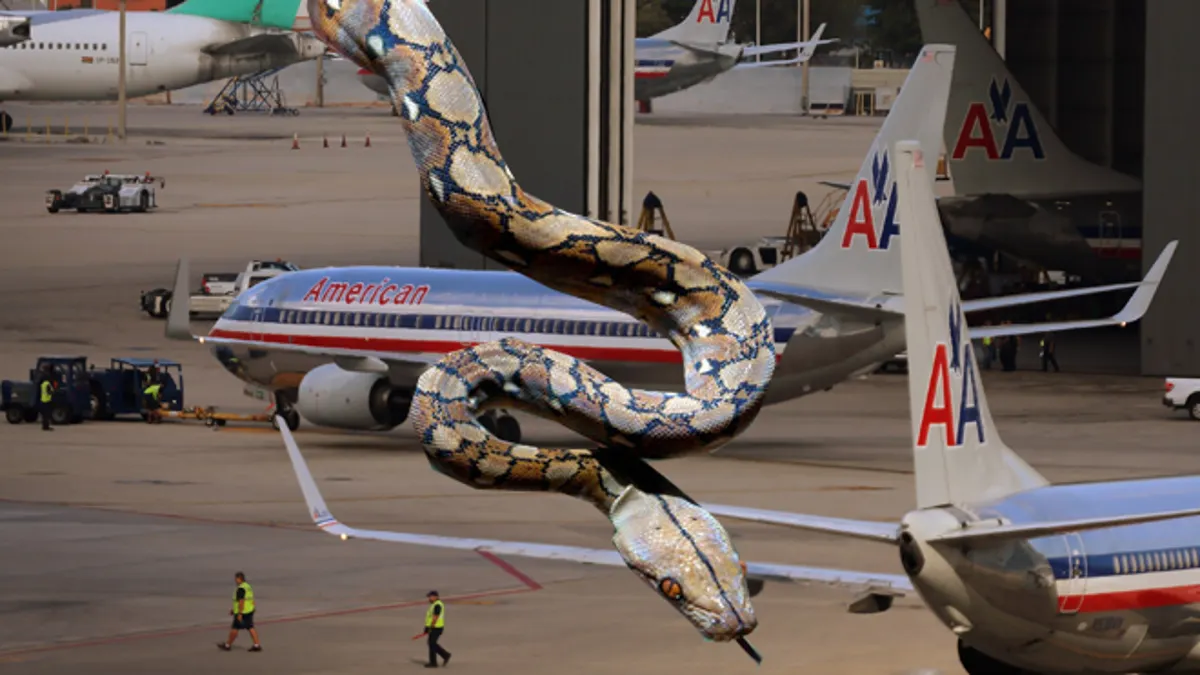Miami International Airport (MIA), known for its bustling terminals and international flights, has recently become the unlikely backdrop for a series of encounters with a less welcome type of passenger—snakes. While airports are typically associated with travel and logistics, MIA has found itself in the midst of a surprising issue: an uptick in snake sightings. This phenomenon raises questions about the environmental and logistical challenges of managing such unexpected wildlife encounters in a major urban transport hub.
The Emergence of a Snakes Problem
In recent years, there has been a noticeable increase in snake sightings at Miami International Airport. These encounters have included a variety of snake species, both native and non-native. The most common sightings involve the Burmese python, a non-native species that has become invasive in Florida, as well as native species such as the Eastern diamondback rattlesnake.
The presence of these snakes at the airport is not entirely random. Miami’s geographic location in South Florida places it in close proximity to the Everglades, a vast and ecologically rich area that is home to numerous snake species. The proximity of the airport to this natural habitat means that wildlife occasionally migrates into the airport’s vicinity, drawn by factors such as food sources or changes in environmental conditions.
Environmental Factors and Snakes’ Habitat
Several environmental factors contribute to the increased presence of snakes at Miami International Airport. The extensive development and urbanization around the airport have encroached upon natural habitats, leading to habitat fragmentation. This disruption forces wildlife, including snakes, to seek new environments as their natural habitats become less hospitable.
Additionally, the changing climate has had an impact on local wildlife. Warmer temperatures and altered weather patterns can influence the behavior and migration patterns of snakes, causing them to move into areas they previously avoided. The combination of habitat loss and climatic changes creates a scenario where snakes are more likely to come into contact with human infrastructure, such as airports.
Challenges for Airport Operations
The presence of snakes poses several challenges for airport operations. Safety is a primary concern. While most snakes are non-venomous and pose minimal risk to humans, some species, such as the Eastern diamondback rattlesnake, are venomous and can be dangerous if provoked. Ensuring the safety of passengers and airport staff requires prompt and effective responses to snake sightings.
Additionally, snakes can cause operational disruptions. Airports are complex environments with numerous facilities, including baggage handling systems, cargo areas, and maintenance zones. A snake sighting or infestation can lead to delays and operational inefficiencies. For example, if a snake is found in a critical area like a baggage claim or cargo hold, it may necessitate a temporary shutdown of that area until the situation is resolved.
Management Strategies and Responses
Miami International Airport has implemented several strategies to manage and mitigate the presence of snakes. These strategies involve collaboration with wildlife experts and pest control professionals to develop effective responses to snake sightings.
One approach is habitat management. By working to reduce the attractiveness of the airport’s surroundings to wildlife, authorities can decrease the likelihood of snakes entering the airport premises. This includes efforts to control vegetation, manage waste, and ensure that potential hiding spots are minimized.
Another key strategy involves the use of professional wildlife removal services. These experts are trained to handle and safely relocate snakes, ensuring that they are removed from the airport environment without harm. Additionally, the airport has invested in training for staff to recognize and report snake sightings promptly, enabling quicker response and resolution.
Public Awareness and Education
Increasing public awareness about the presence of snakes at the airport is also crucial. Informing passengers and airport staff about the potential for snake sightings and educating them on how to respond can help manage the situation more effectively. Signage and informational materials may be used to provide guidance on what to do if a snake is encountered.
Moreover, educational initiatives can help foster a greater understanding of local wildlife and the importance of coexisting with it. By highlighting the ecological role of snakes and the challenges they face, these initiatives aim to promote a balanced perspective and encourage responsible behavior.
Future Considerations and Adaptations
As urban development and environmental changes continue to impact local wildlife, airports like Miami International may need to adapt their strategies for managing wildlife encounters. This could involve investing in more advanced wildlife detection technologies, enhancing habitat management practices, and strengthening partnerships with environmental and wildlife organizations.
In addition, ongoing research into the behavior and movement patterns of snakes can provide valuable insights for developing more effective management approaches. Understanding how snakes interact with their environment and what drives their migration patterns can help in devising strategies to minimize their impact on airport operations.
Conclusion
The presence of snakes at Miami International Airport underscores the complex interplay between urban development, environmental changes, and wildlife behavior. While these encounters present challenges, they also highlight the need for innovative and adaptable strategies in managing wildlife in increasingly developed areas. By combining effective management practices, public education, and ongoing research, Miami International Airport aims to address the issue while maintaining its role as a major global transportation hub. As the airport navigates this unexpected aspect of its operations, it continues to balance the demands of modern infrastructure with the realities of its natural surroundings.
